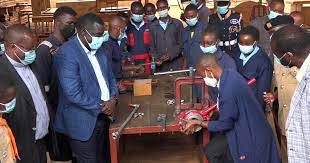The Government is committed to combating the second wave of desert locusts that invaded the country last November from two neighbouring countries, Government Spokesman Rtd. Col. Cyrus Oguna has said.
Oguna explained that about 203 swarms have been sighted since the outbreak with 121 swarms having been contained already, thereby reducing the magnitude of possible damage by the pests.
Oguna in a media briefing today however said that relevant stakeholders are in the process of determining the extent of the damage.
Oguna further said that the National Government is working in partnership with the FAO, World Bank, County Governments, Kenya Defense Forces (KDF) and the Desert Locust Control Organisation for Eastern Africa (DLCO-EA) among other stakeholders to contain the situation.
“The Government has deployed all interventions to contain the situation including collaborating with other development partners such as FAO, World Bank through Emergency Locust Response Program (ELRP) and County Governments,” he said.
Oguna stated that among other key interventions that the government has deployed include Nine Control Bases (for ground and aerial activities) have been established in the Wajir, Isiolo, Marsabit, Masinga, Garissa, Turkana-Lodwar, Mandera, Lamu-Witu, Kitui.
The Government spokesman affirmed that the Government also has enough pesticide for the control, with currently, there is a balance of 320, 000 litres of assorted pesticide.
“The pests control operation has largely been successful in reducing the magnitude of damage caused by the pest and the Government is committed to ensuring total eradication of the pests to ensure food security for all Kenyans,” Oguna stated.
Current reports indicate that so far, about 183 swarms have settled in the country and of this 157 have been controlled reflecting an 86 percent success rate in control efforts, he added.
FAO’s Desert Locust Information Office (DLIS) have predicted that swarms are expected to invade and settle in the months of February and March.
Desert Locust is a unique migratory pest that has the potential to ravage crops and pasture across regions. Here in Kenya, Desert Locust invasion poses a serious threat to achievement of one the pillars of Big Four Agenda – attainment of100 percent. Food and nutrition security in the country.
The locusts initially invaded the counties of Wajir, Garissa, Lamu, Taita Taveta, Samburu, Tharaka Nithi, Embu, Machakos, Isiolo, Tana River, Marsabit, Kilifi and Mandera. Recently, six more counties of Kitui, Laikipia, Meru, Makueni, Kajiado and Nyandarua have sighted movement of some swarms.
by Alice Gworo




